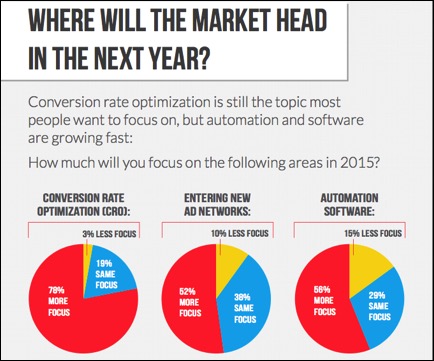In the State of Paid Search, we get to look at how paid search is performing and how it’s progressing. There are areas where focus will either stay the same, increase, or decrease. An area that’s increasing is conversion rate optimization (CRO). The focus on CRO will increase by 79% in the coming year. With that in mind, let’s take a look at CRO, why it’s important to use, best practices used by Hanapin, and the tools we use.

Conversion rate optimization focuses on altering aspects of landing pages to increase the rate of a visitor converting. Whether it’s changing the color of a button or testing headlines to match the PPC ad, there are tools to measure these conversions. With that data, we can implement the changes on the landing pages to increase conversion rate. Once that new change is implemented, testing another element of the page often becomes a best practice.
CRO Rationale
Below are a few best practices of CRO:
- Intention of Change – It becomes important to change an element on a page for a reason. What will be more appealing to the consumer? Are the colors clashing or working well together? These are just a few questions to ask when coming up with ideas on what to test.
- Test, Test, Test – Did I say test? When we’re able to track the behavior of visitors on a site, we can see which change was more successful. Continually testing will help in finding our optimal conversion rate. Also, give your test some time to gain significance.
- One Change at a Time – When we’re looking at what element to change and test, it becomes important to keep it to a minimum. If we have multiple changes on the same landing page, we might not know which element actually enforced the change in visitor behavior.
- Reporting – Data is only as good as it’s reported. If we can’t clearly communicate the data with the client, it won’t be as useful in explaining why we should implement the changes. Reporting with screen shots of the tests themselves becomes helpful for the client to visually see the changes and approve.
- Implementation – Once a winner is declared, implementation is the next hurdle. While we know our clients and their IT departments are quite busy, we still want them to implement these changes so they become permanent on their site. Sending over exact instructions on how to implement these changes is a great resource for our clients to make implementation easier and faster.
Download the entire 2014-2015 State of Paid Search right now!
Our Hanapin CRO team uses quite a few different software programs to help us create these landing page tests and implement the changes we want to see. We also use a few programs for user feedback to get more of an unbiased opinion on our pages and if the changes would be effective or not. Below are a few of the larger programs we use.
UsabilityHub
We use this program to test user behavior and preferences. We’re able to get results and responses, sometimes demographically, to help us decide what would be worthwhile testing.
CrazyEgg
This program provides us with heatmaps and clickmaps, additional resources to measure behavior of visitors once they visit our site. How far are they scrolling down? Are they trying to click on text or an image that isn’t a link? Just a few examples of insights we receive from using CrazyEgg.
Optimizely
We use Optimizely primarily for editing our clients’ websites and implementing the changes we put together. After, we’re able to set up tests through Optimizely and view results.
Unbounce
Unbounce gives us the ability to create landing pages that align with the overall branding of the client. If the client doesn’t have the capability to provide us with these types of pages, we can utilize Unbounce and implement our own landing pages.
Final Thoughts
The tools listed above along with our CRO best practices provides our clients a thorough and perhaps new look at what their site could do better and how it’s communicating a message. By aligning with our paid search efforts, CRO has helped conversion rates overall and has provided new insights to our clients and their other marketing efforts.



